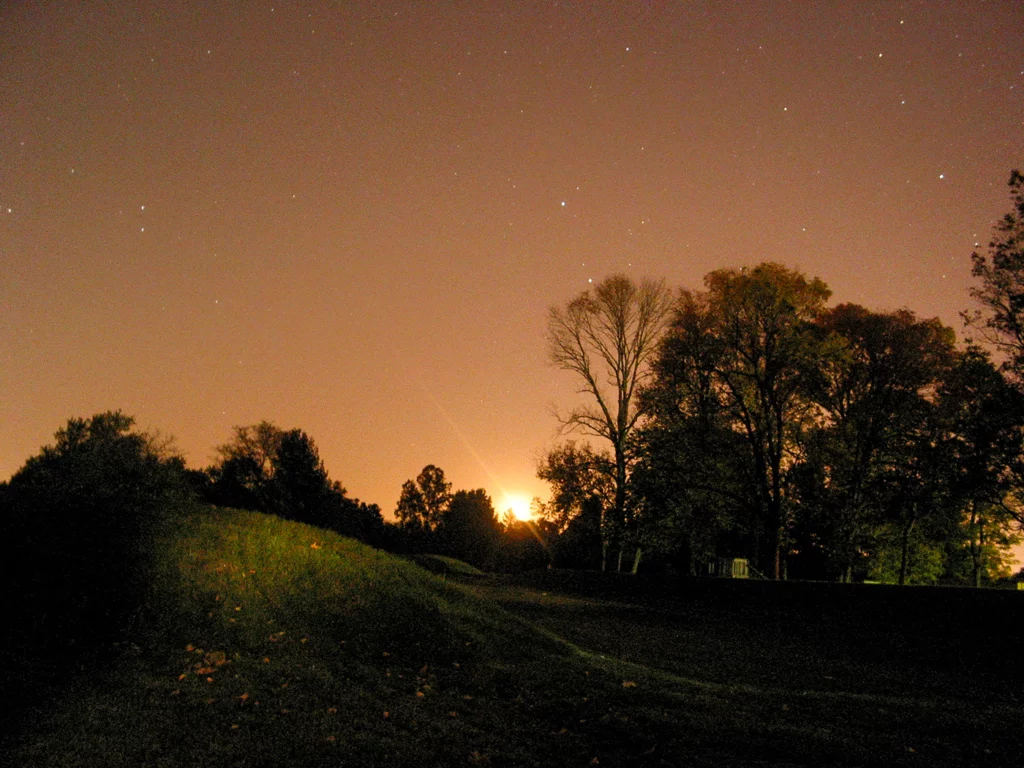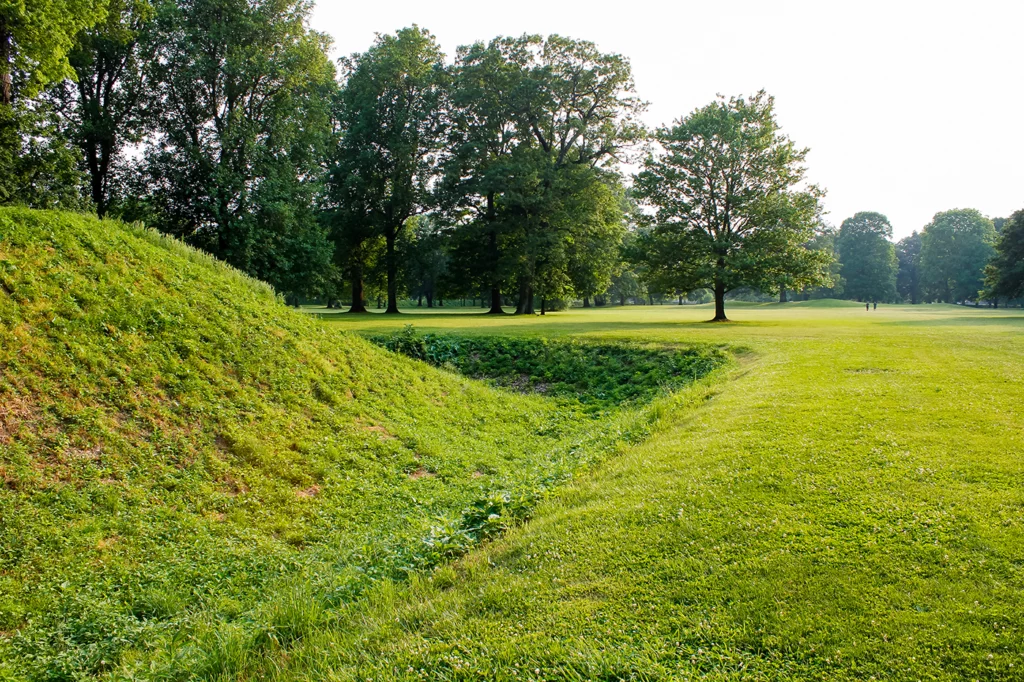Native Sites in Ohio Named to World Heritage List
This article was published by Yes! magazine in November 2023.

The eight earthworks complexes in central and southern Ohio join nearly 1,200 sites worldwide that UNESCO has said have outstanding value to humanity. The earthworks are now peers of Machu Picchu, Stonehenge, Taj Mahal, and other magnificent places, according to Jen Aultman, chief historic sites officer of the Ohio History Connection (OHC), which shepherded the World Heritage application through an arduous multiyear process. Other sites added this year include temples in India and a 9th-century Tunisian settlement.
Indigenous people built the Hopewell Ceremonial Earthworks between 1,600 and 2,000 years ago. Their rounded, grass-covered walls rise 14 to 20 feet to define octagons, circles, squares, and other geometric shapes that each encompass many acres. One complex—in Newark, Ohio—covers a total of 4 1/2 square miles. Stonehenge would fit into a tiny corner. Walking through the earthworks’ curving green forms is both inspiring and disorienting.

The monumental figures align precisely with astronomical events as well as with each other, even when separated by hundreds of miles. The major alignments mark the moon’s 18.6-year south-to-north rises and sets. At the gigantic Octagon Earthworks, in Newark, the moon rises through one of its gates, or openings, at the moment of the northern standstill—the northernmost point of the 18.6-year cycle.
In constructing the giant shapes, the earthworks’ builders repeatedly and spectacularly solved a primordial math problem that confounded other mathematicians as far back as ancient Greece. Brad Lepper, OHC’s curator of archaeology and an Ohio State University anthropology professor, has written that some of the earthworks’ huge circles and squares were constructed with equivalent surface areas. This is called “squaring the circle,” an expression that has come colloquially to mean doing the impossible. Other earthworks circles and squares have equal perimeters, called “rectifying the circumference.”
Some of the math is more esoteric than visible. In one case, the distance between two figures’ centers was used as a gigantic measuring stick for laying out the rest of the site. In other instances, connecting forms with imaginary lines creates related hypothetical forms overlaid precisely on the ones we can walk among.
The earthworks’ makers were virtuoso astronomers, architects, and mathematicians, Wallace concluded, calling them “uncommon geniuses.” Their “genius lives on today in many descendant tribes,” she said.
Unlike the pyramids of Egypt and cathedrals of Europe, no central authority directed the earthworks’ vast and meticulous construction. Instead, the evidence suggests members of dispersed Indigenous communities built the massive shapes one basket load of dirt at a time. Finely crafted statuary and other objects found in the earthworks were made of materials from both local and distant places. These include Ohio’s multicolored flint and its rivers’ freshwater pearls, along with obsidian from the Rocky Mountains, mica from the Southeast, copper from the Great Lakes region, and shells originating in the Gulf of Mexico.
The geographic range of the materials’ sources indicates how widely the earthworks were valued, according to UNESCO. A representative called them “the center of a continent-wide sphere of influence and interaction.”

The Great Circle Earthworks in Heath, Ohio, are among the Hopewell Ceremonial Earthworks UNESCO has placed on the World Heritage list. Photo by Joseph Zummo.
The Importance of Homeland
The day following the World Heritage announcement, members of the United States delegation to Riyadh gathered. “It’s an incredible accomplishment,” said Alex Wesaw of the Pokagon Band of Potawatomi Indians, OHC’s director of American Indian relations. He called the UNESCO decision a win for all of Native America. He pointed out that we don’t know what the “Hopewell” people called themselves; archaeologists dubbed them that after identifying earthworks on a farm whose owner was named Hopewell.
Chief Wallace recalls a soft rain falling during a 2007 Eastern Shawnee visit to the earthworks. The tribe had been expelled from the state during the 19th century following the Indian Removal Act of 1830. Many of its citizens died on the approximately 800-mile walk from Ohio to Oklahoma, then called “Indian Territory” and set aside for tribes. As soon as they arrived, the chiefs begged for food for their starving people, Wallace said. “Our pain was so very difficult and so very deep for so very long, it needed a gentle rain to wash it away,” she said. “One woman in the group said our ancestors were weeping with joy because we had returned to the homeland.”
“Homeland” is vital as a place and as a concept because it’s “where our stories and our history originate,” said Logan York of the Miami Tribe of Oklahoma. The Miami civilization centers on the lands in Ohio and surrounding states from which the tribe was forcibly removed in 1846, York explains. “It seems like a long time ago but is a blink of an eye for culture. A lot of our ways of doing traditional things are still centered in our traditional homelands.”
Helping younger generations understand this is critical for removed tribes. Chief Billy Friend of the Wyandotte Nation, another Ohio tribe, has taken young tribal citizens on bus tours of the state. He said Ohio “is where my ancestors stood, partook of ceremonies, and fought.” Teaching youngsters this history, Friend said, “preserves the future of our past.”
Joshua Garcia, media and communications specialist for the Wyandotte Nation Cultural Center and Museum, first joined Chief Friend’s tours when he was just 12 years old. The trips counteract the damage from the decades during which “it was not good to be Native,” according to Garcia. Growing up, his grandmother was not allowed to go to ceremonies because they were seen as “full of supposedly bad things,” he recounts. His mother took it upon herself to help restore traditional knowledge and is now the Wyandotte cultural preservation officer, Garcia said.
Heritage for the World
The idea of proposing the Hopewell Ceremonial Earthworks to the World Heritage list began percolating some 35 years ago, said Lepper. Early supporters included Newark Earthworks Center officials Richard Shiels, an Ohio State University emeritus professor, and Marti Chaatsmith, who is Comanche and Choctaw. About eight years ago, an application began to coalesce, and in January 2022 the Department of the Interior submitted it to UNESCO. According to Lepper, the tribes contributed mightily to the application and will continue to be involved in OHC earthworks-related decisions; for example in developing site-management plans and reviewing research proposals. “Working closely with our Indigenous partners is what we do now, and we won’t do anything without them,” he said.
Important cross-cultural research includes Lepper’s collaboration with Chief Ben Barnes of the Shawnee Tribe. In 2018, the two published a scientific paper comparing engraved spherical black stones used by the Hopewell peoples with those used by Shawnees of today when constructing ceremonial water drums. “I am so thrilled to have been a co-author on a paper with a Shawnee chief, and Ben said he’s thrilled to have been a co-author on a paper with an archaeologist,” Lepper reports.
Increased publicity for the Hopewell Ceremonial Earthworks means Ohio anticipates more earthworks-oriented tourism. State legislative representative Jessica Miranda (D-Forest Park) said the World Heritage listing will attract visitors “to see the beauty of our lands and our very diverse state.” Bill Seitz (R-Cincinnati) spoke of recognizing Native contributions and being “respectful to their history.”
The grand complexes named to the World Heritage list are closely monitored by OHC and the National Park Service, but additional earthworks dot the Ohio landscape, having survived centuries of plowing and development. Hawks and other raptors surf the thermals above both grand and solitary earthworks. Below, in a photo by Joseph Zummo, an avian visitor spirals gracefully overhead as its avian forebears have likely done since Indigenous ancestors built the site all those years ago.
The heightened publicity won’t change the situation of these earthworks for better or worse, according to Lepper. “Looters already know about the isolated earthworks, off in the woods and fields, with no monitoring,” he said. “They are the ones that are really at risk and always have been.” That’s largely because out-of-the-way earthworks are usually on private land, where the federal Native American Graves Protection and Repatriation Act does not necessarily apply, he said. A state graves-protection law would be an important next step.
For Aultman, the significance of safeguarding humanity’s special places was driven home in 2019, when fire ravaged another World Heritage site, Paris’s Notre Dame Cathedral. Continual news coverage and social media posts meant the event was witnessed repeatedly worldwide. “We all felt we would be lesser as humans if it were gone,” she said.
On October 14, Wallace was the keynote speaker at a celebratory event held in an earthworks complex (seen above in a photo by Joseph Zummo) in Chillicothe, a city in south-central Ohio. Other speakers included Mike DeWine, Ohio’s governor, and National Park Service Director Chuck Sams, a citizen of the Confederated Tribes of the Umatilla Indian Reservation, in Oregon.
“Chillicothe” is a Shawnee word meaning “the great place” and “the place of chiefs and leaders,” Wallace said in her keynote speech. “This place was the center of North America … the center for spirituality, the center for love, the center for peace.” Disseminating this understanding is the task ahead, according to Wallace.
Addressing Native Americans in the crowd, Wallace said, “It was our ancestors, our geniuses who built these places.” And, she assured them, “the world now knows.”
Text c. Stephanie Woodard; four photographs c. Joseph Zummo.



